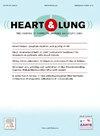胺碘酮预防非体外循环冠状动脉搭桥术术后房颤
IF 2.6
4区 医学
Q2 CARDIAC & CARDIOVASCULAR SYSTEMS
引用次数: 0
摘要
术后心房颤动(POAF)是心脏手术后常见的并发症,其发病率随着手术复杂性的增加而增加。虽然CHA₂DS₂-VASc评分已被证实可预测POAF风险,但标准化的预防策略仍不清楚。本研究评估了低剂量口服胺碘酮方案在接受孤立OPCAB手术的高危患者中预防POAF的安全性和有效性。目的评价低剂量胺碘酮预防高危OPCAB患者POAF的效果。方法:这项经irb批准的前瞻性研究纳入了2018年6月至2021年6月在单一三级医疗机构接受隔离OPCAB手术的所有成年住院患者,这些患者被确定为POAF高风险(术前CHA2DS2VASc评分>;2)采用胺碘酮预防治疗的患者与实施胺碘酮预防治疗前在同一中心接受类似OPCAB程序的回顾性历史对照组进行比较。术前住院住院患者在术前每天接受体重调整剂量的口服胺碘酮,直至手术前一天。负荷不足(1 g)的患者在手术室静脉注射150 mg胺碘酮。术中出现症状性心动过缓的患者接受临时预防性心外膜起搏导线。术后,所有患者均接受胺碘酮治疗,200mg口服,每日2次,持续15次或直至出院。采用多变量logistic模型确定低剂量口服胺碘酮预防新发POAF的效果。结果研究组需治疗的POAF发生率降低10.7% (OR=0.4;95% CI [0.167-0.958], p = 0.04),出院时需要房颤治疗的患者减少12% (p = 0.017),拔管时间显著缩短。两组间所有基线特征和安全参数相似。结论采用低剂量胺碘酮预防方案可显著降低新发POAF,且无明显不良反应。该方案可被认为是安全、有效和可行的,适用于高风险的OPCAB患者。需要对无泵CABG和瓣膜患者进行进一步的研究。本文章由计算机程序翻译,如有差异,请以英文原文为准。
Amiodarone Prophylaxis against postoperative atrial fibrillation in off-pump coronary artery bypass
Background
Postoperative atrial fibrillation (POAF) is a common complication after cardiac surgery, with incidence increasing based on surgical complexity. While the CHA₂DS₂-VASc score has been validated to predict POAF risk, standardized prophylactic strategies remain unclear. This study evaluates the safety and efficacy of a low-dose oral amiodarone protocol for POAF prevention in high-risk patients undergoing isolated OPCAB procedures.
Objective
To evaluate the impact of low-dose amiodarone prophylaxis against POAF in high-risk patients undergoing OPCAB procedures.
Methods
This IRB-approved prospective study included all adult inpatients undergoing isolated OPCAB procedures at a single tertiary care facility between June 2018-June 2021 identified as high risk for POAF (preoperative CHA2DS2VASc score > 2). Patients treated with amiodarone prophylaxis were compared to a retrospective historical control group which underwent similar OPCAB procedures in the same center prior to the implementation of amiodarone prophylaxis. Preoperative hospitalized inpatients received a weight-adjusted dose of oral amiodarone on each preoperative day until the day prior to surgery. Patients who were inadequately loaded (<1 g) received 150 mg of amiodarone intravenously in the operating room. Patients with intraoperative symptomatic bradycardia received temporary prophylactic epicardial pacing wires. Postoperatively, all patients received an amiodarone regimen of 200 mg orally twice daily, continued for 15 doses or until discharge. Multivariate logistic models were used to determine the effect of low-dose oral amiodarone prophylaxis on new-onset POAF.
Results
A 10.7 % reduction in incidence of POAF requiring treatment was noted in the study group (OR=0.4; 95 % CI [0.167–0.958], p = 0.04), as well as a 12 % decrease in patients requiring AF treatment at discharge (p = 0.017), and significantly reduced time to extubation. All baseline characteristics and safety parameters were similar between groups.
Conclusions
The use of a low-dose amiodarone prophylaxis regimen led to significant reduction in new POAF, without apparent adverse effects. This regimen may be considered safe, effective, and feasible for implementation in high-risk OPCAB patients. Further studies in on-pump CABG and valvular patients are needed.
求助全文
通过发布文献求助,成功后即可免费获取论文全文。
去求助
来源期刊

Heart & Lung
医学-呼吸系统
CiteScore
4.60
自引率
3.60%
发文量
184
审稿时长
35 days
期刊介绍:
Heart & Lung: The Journal of Cardiopulmonary and Acute Care, the official publication of The American Association of Heart Failure Nurses, presents original, peer-reviewed articles on techniques, advances, investigations, and observations related to the care of patients with acute and critical illness and patients with chronic cardiac or pulmonary disorders.
The Journal''s acute care articles focus on the care of hospitalized patients, including those in the critical and acute care settings. Because most patients who are hospitalized in acute and critical care settings have chronic conditions, we are also interested in the chronically critically ill, the care of patients with chronic cardiopulmonary disorders, their rehabilitation, and disease prevention. The Journal''s heart failure articles focus on all aspects of the care of patients with this condition. Manuscripts that are relevant to populations across the human lifespan are welcome.
 求助内容:
求助内容: 应助结果提醒方式:
应助结果提醒方式:


